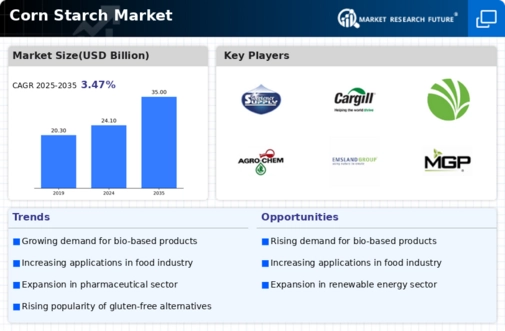Market Share
Corn Starch Market Share Analysis
The Corn Starch Market, a significant player in the global food and industrial ingredient sector, is subject to various market share positioning strategies that influence its competitive landscape. One primary strategy employed by companies operating in this market is product differentiation. Given the versatility of corn starch in various industries, including food and beverage, pharmaceuticals, and textiles, companies strive to distinguish their products by focusing on unique attributes such as purity, viscosity, and texture-enhancing properties. By offering differentiated products, companies aim to carve out a niche for themselves in the market and attract consumers seeking specific functionalities.
Another key market share positioning strategy is cost leadership. Some players in the Corn Starch Market focus on optimizing production processes, economies of scale, and efficient supply chain management to achieve cost advantages. By offering corn starch at competitive prices, these companies target a broader customer base and aim to capture a larger market share. This strategy is particularly relevant in price-sensitive markets where consumers prioritize cost-effectiveness without compromising on product quality.
Innovation and research and development (R&D) efforts also play a pivotal role in market share positioning within the Corn Starch Market. Companies invest in developing new and improved corn starch derivatives with enhanced functionalities, such as modified starches with better stability or specialty starches with unique applications. Innovations in processing technologies and sustainable sourcing practices are also leveraged to differentiate products and gain a competitive edge in the market. By staying ahead in terms of innovation, companies can attract customers looking for cutting-edge solutions and maintain or expand their market share.
Strategic partnerships and collaborations are becoming increasingly common in the Corn Starch Market as companies seek to strengthen their positions. Forming alliances with distributors, suppliers, or other industry players can provide access to new markets, technologies, or raw materials. Joint ventures and collaborations may also facilitate the sharing of expertise and resources, enabling companies to collectively address market challenges and capitalize on emerging opportunities. These partnerships contribute to a more robust market presence and can be instrumental in expanding market share.
Geographic expansion is another market share positioning strategy employed by companies in the Corn Starch Market. By entering new regional markets or strengthening their presence in existing ones, companies can tap into diverse consumer preferences and market dynamics. This strategy involves understanding local regulations, adapting products to meet regional preferences, and building strong distribution networks. Successfully expanding geographically allows companies to capture a larger share of the market and establish themselves as key players on a global scale.
Environmental and sustainability considerations are increasingly influencing market share positioning in the Corn Starch Market. With growing awareness of environmental issues, consumers and businesses alike are prioritizing sustainable and eco-friendly products. Companies that adopt sustainable sourcing practices, invest in eco-friendly packaging, and demonstrate commitment to environmental responsibility can attract environmentally conscious consumers, potentially gaining a competitive advantage and market share.










Leave a Comment